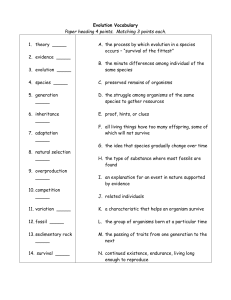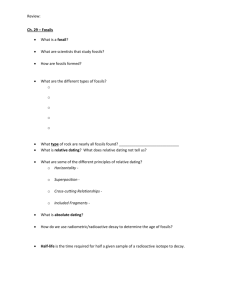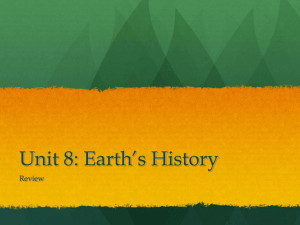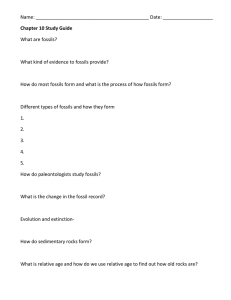The History of Life - Grant County Schools
advertisement
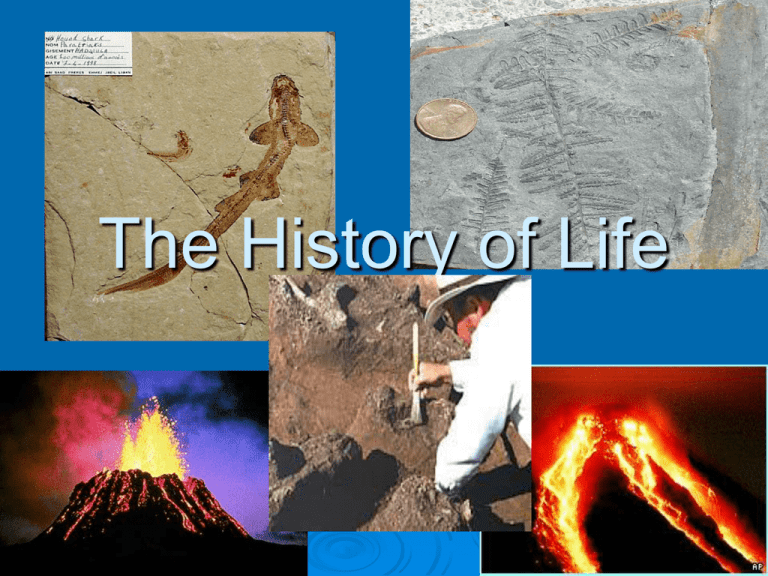
The History of Life The Record of Life You may have seen thrilling movies or read books that describe travel in time. The characters often encountering strange organisms. Did the differences you saw surprise you? After all, everything changes over time. It is difficult to imagine what Earth might have been like that long ago! Early History of Earth Early Earth was inhospitable! It was probably very hot, volcanoes might have erupted frequently spewing gases and lava • These gases helped form Earth’s early atmosphere which contained little oxygen but abundant carbon dioxide and nitrogen About 3.9 billion years ago, earth might have cooled enough for water in the atmosphere to condense • This would have led to millions of years of rainstorms, enough to fill Earth’s oceans It is in the oceans that scientist propose that the first organisms appeared between 3.9 and 3.5 billion years ago History in Rocks Scientist cannot be sure that earth formed in this way. There is no direct evidence of the earliest years of Earth’s history. The physical processes of Earth constantly destroy and reform rock. The oldest rocks that have been found on earth formed only about 3.9 billion years ago Rocks are an important source of information about the diversity of life that once existed on the planet Fossils – Clues to the Past The millions of species that live today are probably only a small fraction of all the species that ever existed. About 99% of species are extinct – they no longer live on Earth – evidence of an organism that lived long ago. Fossil Scientists use fossils to learn about ancient species. Fossils Cont. A person who studies fossils is a Paleontologist Fossils can form in many different ways. Fossils are used to understand Events that happened long ago Kinds of organisms that lived in the past Behavior of organisms that lived in the past Ancient climate and geography Could ferns have lived in Antarctica? Scientist have discovered fossil remains of ferns in the rocks of Antarctica. These fern fossils are related to ferns that grow in temperate climates on Earth today. How did they get there? Pangaea link How fossils form Fossils occur in sedimentary rocks What is a sedimentary rock? Fossils form when organisms are buried in small particles of mud, sand or clay soon after they die. Over time, the particles compress and harden into sedimentary rock Fossils can still form today in the bottom of lakes, streams and oceans. The Fossilization Process Describe how the movements of earth might expose a fossil. Why do you think that fossils are rare in igneous and metamorphic rock? Follow this link to see the process Fossils in different layers of sedimentary rock vary in age Ways of dating fossils Relative dating – The deeper the layer of rock, the older the fossil is. Layers closer to the top are younger (Geologic law) • Relative dating only gives you an estimate of age, not the actual age of a fossil Radiometric dating – Uses radioactive isotopes in rocks or fossils (radioactive isotopes break down over time giving off radiation) • Decay rate of the isotopes can measured – half life • Scientist use potassium-40 to date older samples (1.3 billion years) and carbon-14 to date fossils less than 50,000 years old The Geologic Time Scale By examining layers of sedimentary rock and dating the fossils that are found in the layers, scientists have been able to put together a chronology (calendar) of the Earth’s history. Draw the geologic time scale on pg 383 and 384. Be sure to include major life forms, major events, the period, era and time in years on your time scale. Make your time line to scale. How do we know how old fossils are? Dating – dating of fossils based on depth Relative Layers at the surface are younger than those at deeper layers Just an estimate, not really accurate Radiometric dating – uses radioactive isotopes in rocks or fossils Radioactive isotopes are atoms with unstable nuclei that decay over time giving off radiation Radioactive isotopes form a new element after they decay All radioactive isotopes have a characteristic decay rate which scientist use Half life – time it takes for half of the radioactive isotope to decay into a new element – used to measure decay rate Example When a rock forms it contains radioactive isotopes that decay to half of its original amount in 1 million years. Today, if a rock contained equal amounts of the radioactive isotope and the new substance, the rocks would be 1 million years old. Scientists use potassium-40, a radioactive isotope that decays to argon-40, to date rocks containing very old fossils. Chemists have determined that potassium-40 decays to half its original amount in 1.3 billion years Scientist use carbon-14 to date fossils less than 50,000 years old History of Life - Review What was early earth like? How do we think oceans were formed? When? When and where do we think life began? How do we know about organisms from the past? How do fossils develop? How can we determine the age of a fossil? What four eras is the geologic time scale divided into? What types of organisms mark each era? The continents were at one time joined together in a landmass known as Pangaea. How long ago was that? Refer to your geologic time scale to understand when that occurred. Summarize the trend of how organisms developed during Earth’s history. The Origin of Life Francesco Redi’s experiment (1668) How do the results differ in the two jars? What might you conclude from these results? Louis Pasteur’s experiment – finally disproved spontaneous generation (mid 1800’s) Which came first, the chicken or the egg? Biologists have accepted the concepts of biogenesis for more than 100 years Biogenesis does not answer the question of how life began on Earth No one will ever know for certain how life began on earth. We can only make hypotheses about conditions on early Earth. How does chemistry become life?? Evolution of complex molecules Primordial Soup Step 1: simple organic molecules must have formed (molecules that contain carbon) Step 2: Simple organic molecules must have become organized into complex organic molecules (proteins, carbohydrates, and nucleic acids) 1930’s Oparin (Russian) – hypothesized that life began in the oceans Energy from sun and lightning triggered chemical reactions to produce small organic molecules from substances in the atmosphere 1953 Miller and Urey (American) – replicated conditions in the lab and produced amino acids, sugars, and other molecules The next step… How did we get from simple organic compounds to complex organic compounds? In the presence of heat, without oxygen, amino acids link to from proteins. ATP is produced in a similar way. Sidney Fox found that if you continued to heat the complex organic compounds protocells developed. The Evolution of Cells The first true cells… Prokaryotes that evolved from a protocell Anaerobic (no oxygen present in atmosphere) Food – organic molecules abundant in oceans Autotrophs evolved to inhabit harsh conditions (ie. Archaebacteria) Endosymbiont Theory Eukaryotes probably evolved from prokaryote cells Theory proposes that eukaryotes evolved through a symbiotic relationship between prokaryotes Evidence: • Chloroplast and cyanobacteria – resemble eachother • mitochondria and bacteria – some look similar • Chloroplast and mitochondria contain DNA that is similar to the DNA in prokaryotes • Today, some prokaryotes live in close association with eukaryotes Life Today Could new life originate on Earth today? List the specific evidence that supports each conclusion. Life comes from existing life Life probably originated on Earth through the reaction of chemicals in Earth’s atmosphere and their further reaction on Earth’s surface Cells probably evolved as the chemicals on early Earth became more organized.
